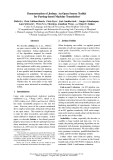
Algorithm for grammars
-
We describe Joshua (Li et al., 2009a)1 , an open source toolkit for statistical machine translation. Joshua implements all of the algorithms required for translation via synchronous context free grammars (SCFGs): chart-parsing, n-gram language model integration, beam- and cubepruning, and k-best extraction. The toolkit also implements suffix-array grammar extraction and minimum error rate training. It uses parallel and distributed computing techniques for scalability.
 4p
4p  hongphan_1
hongphan_1
 15-04-2013
15-04-2013
 46
46
 2
2
 Download
Download
CHỦ ĐỀ BẠN MUỐN TÌM














